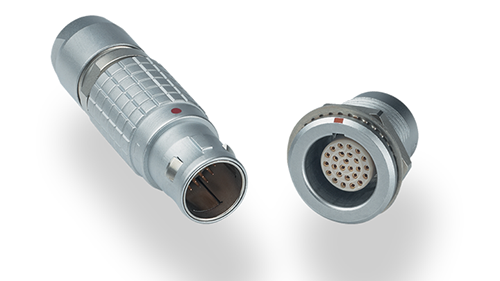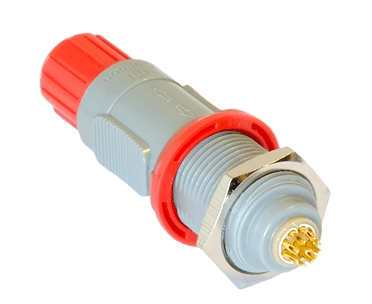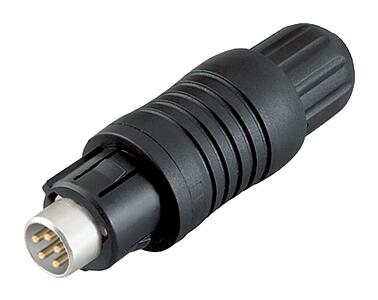M Series Connectors
Are lightweight triplestart ratchet coupling type connectors designed for avionics, aerospace, Harsh Environment Connectors, security, motorsport and heavy duty applications.
The push-pull connector is an innovative type of connector that possesses distinct characteristics. Invented by LEMO, this cylindrical socket incorporates a certain degree of elasticity, enabling the connector to self-lock when pushed into place. It requires specific actions such as pulling, rotating, or other designated unlocking maneuvers to establish or disconnect the connection, ensuring prevention of accidental disengagement.
The push-pull circular connectors are available in various sizes, voltages, and pin configurations, along with different configuration options such as coaxial, triaxial, fluidic, and pneumatic. They find wide applications in medical devices and facilities, Harsh Environment Connectors vehicles and Harsh Environment equipment, instrumentation, as well as in applications that may entail catastrophic or hazardous consequences.

Typically manufactured from lightweight materials like plastic or metal, push-pull connectors offer high strength and durability, providing thousands of insertion and withdrawal cycles. With their built-in locking mechanisms, they contribute to the sleek and streamlined appearance of equipment.
The locking mechanism of a Lemo connector is typically based on a male plug with an inner sleeve that incorporates a latch, which is secured in place by an outer sleeve. When the connector is locked, the inner sleeve latch retracts and slides along the interior of the socket until it aligns with the groove contour of the socket. The latch engages into the socket groove, thereby locking the connector. To unlock, simply pull the outer sleeve to disengage the latch from the groove, allowing for easy removal of the plug.
Most industrial-grade push-pull connectors are circular in shape and capable of accommodating complex cable assemblies. One economical method for manufacturing high-tolerance components is by machining round bar stock. Internal components such as contacts, insulators, gaskets, collets, and collet nuts are also typically circular in shape. These connectors are suitable for both indoor and harsh outdoor environments, featuring attributes such as waterproof ratings (such as IP68), dust resistance, vibration resistance, and impact resistance.
Push-pull connectors can have unique keying to restrict specific plug and socket combinations for mating. The design can use either standard or reverse polarity contacts, depending on which end of the cable the power supply is on. In metal connectors, the shielding layer runs through the housing, ensuring 360° continuity and providing EMI protection.
Ergonomic design is a hallmark of this type of Lemo circular connector. The push-pull locking mechanism allows users to easily connect or disconnect with minimal effort. An audible or tactile “click” confirmation provides users with reassurance that the connection is complete and secure, eliminating the need for repeated checks or visual confirmation. This enables users of all skill levels to quickly and reliably connect their devices. Keying, color coding, and LED options further enhance this assurance.

Standard
The absence of a unified certification or standard for guiding the design of Lemo circular connectors has led to significant variations among manufacturers’ products and poor interoperability. The design and testing of many Lemo products adhere to market-specific standards, such as the medical electrical safety standard IEC 60601-1 and the Harsh Environment Connectors durability standard MIL-STD-810F.
Matching cycle
The design of push-pull circular connectors using plastic materials typically ensures a minimum of 2000 mating cycles, while the metal versions offer a minimum of 5000 mating cycles, depending on the manufacturer.
Interval
They can tightly install push-pull connectors together without the need for bulky tools. This is because they only require two fingers to grasp the housing to connect or disconnect.
Material
Metals used for circular Lemo connector housing materials include copper, stainless steel, gold and alloys. In the medical market, the choice of plastic or polymer materials should be easy to clean and aesthetically pleasing. Materials used in this market are typically pressure-resistant and capable of withstanding high-pressure sterilization, UV disinfection, and other disinfection processes. In some cases, they may require biocompatible materials. Lemo circular connectors used in space and other markets may need to meet leakage requirements.
Robustness
Rugged push-pull circular connectors and their cable assemblies possess specific durability attributes, ensuring robust performance in high-reliability and harsh environmental applications, including those subjected to extreme temperatures, radiation, rough handling, chemicals, and other environmental factors.
Sealing
Many manufacturers offer IP sealing ratings for protection against fluid and particle ingress. The sealing inside the connector can enhance the sealing performance by using O-rings and flexible polymer sealing sleeves.
Electromagnetic Interference
Electromagnetic Interference (EMI) or Radio Frequency Interference (RFI) is a significant concern in environments filled with electronic devices, such as medical facilities and aviation. The use of metal in the housing and grounding terminals helps mitigate this impact, and some manufacturers can provide enhanced shielding performance.

Medical (portable, handheld, diagnostic equipment), industrial (automation control, robotics), test and measurement (analyzers, test equipment), air conditioning (event wiring, broadcast equipment), communications (antennas, radar, radio equipment), automotive (diagnostic and production equipment), aviation (Harsh Environment wear equipment, portable equipment), transportation (rail signals, surveillance systems).

The selection of a suitable connector is crucial as it can significantly impact the functionality of the entire device. Careful consideration of various details is necessary to avoid purchasing incompatible connectors.
1.Connector Type
The first consideration is determining the type of connector based on factors such as what needs to be connected and the operating environment. Some connectors are panel-mounted, while others are directly wired. Depending on the situation, you can choose fixed and floating sockets respectively. The type of connector will also depend on the connection object, whether it requires board terminals, crimp terminals, or solder terminals, and the number of conductive terminals needed.
2.Electrical Requirements
Electrical requirements are a critical aspect when selecting a connector. These requirements are primarily based on voltage and current considerations. Connectors with different pin sizes can accommodate varying levels of current and voltage. Users need to choose a connector that aligns with the device’s voltage and current specifications. In addition, we also need to consider other electrical conditions. Such as resistance, allowable resistance variation, millivolt drop, maximum current value, maximum voltage value, characteristic impedance, VSWR, insertion loss and EMI shielding efficiency, etc.
3.Environmental Requirements
The performance of the connector is directly influenced by environmental conditions such as temperature and humidity. Therefore, when selecting a connector, one should consider the anticipated usage environment. Where the connector will be used, whether indoors, outdoors or in a corrosive environment. These will determine the need to strengthen the connector’s sealing or add a shielding shell to the insulator. In addition, the description of the environment should cover information on shelf life and other relevant storage conditions, as well as requirements for shock and vibration. Including transportation needs, and production environmental conditions such as soldering temperatures and soldering cycle durations.
4.Mechanical Performance Requirements
For the connector, what size and coverage area is effective? What is the allowable dimensional tolerance? What is the plugging force of the terminal? And what is the durability (frequency of plugging and unplugging) of the connector? Consider these factors when selecting an electrical connector.